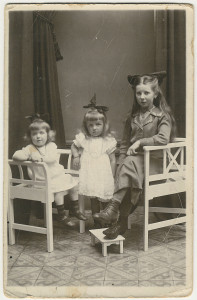When you find enough evidence to answer your initial research questions, it is tempting to move on to another family. But you can discover a whole lot more if you make the effort to find all available records. In this case study, I will show you how you can find out more about the lives of your ancestors using information from Population Registers.
Example: Maria Gommeren
When I first researched my great-great-grandmother Maria Gommeren (1864-1918), I stopped looking for records once I proved her parentage and knew when and where she was born, married and died. Wanting to know more about her life in between these events, I recently took the time to collect all the population registers for her.
Here are some fascinating details about her life that I discovered:
- Maria moved around a lot after her second marriage to Adrianus Luijten. She married him in 1898 and died in 1918. In those twenty years, they lived at 28 different addresses, in eight different towns in two different provinces. That produced a lot of records!
- Their youngest child was named Christiana Maria. Before this, I had only found her death certificate, which lists her as a stillborn daughter, without a name.1 According to the population regsiter, her name was Christiana Maria and she lived for two days.2 I can now record her with her name instead of the impersonal ‘stillborn daughter’ that I had previously.
- After Maria’s death, her husband could not be located when the 1920 census was taken.3 He did not live at the address where he was registered, even though he still had a 15-year-old daughter, Maria, living at home. There were no other adults living with her so apparently she was left to her own devices. I had previously found him imprisoned for being a vagabond so apparently he hit the road again after his wife died. He shows up again in 1922 when he remarries.
I have a family photograph of my grandmother Toos and her sister Annie (daughters of Maria Luijten’s half-sister Adriana Trouw) that also includes Maria. The picture must have been taken around 1918/1919, since Annie and Toos were born in 1916 and 1917 and the youngest girls look to be no more than three years old. This is right in the period between Maria Gommeren’s death in 1918 and Adrianus Luijten’s absence in 1920. I think Maria might have stayed with her half-sister even though that was not her official address. The population register shows that Maria moved to Velp in 1920 so that is something to follow up on. Was she sent to an orphanage?
Conclusion
By putting the data of all of these records together, we can ‘read between the lines’ and see the contours of a story that no record tells by itself. Unfortunately, it is not a happy tale.
The records show us a poor family, who lost a daughter. When we see all the different addresses, it suggests that perhaps Adrianus Luijten could not keep a job and did not make enough money to pay the rent. His absence after his wife’s death also indicates that he was not up to the responsibilities of raising a family.
By meticulously analyzing all the details I could find, I feel like I have come to know Maria a little. She is no longer just a name in my database.
What stories about your own family are out there waiting to be discovered?
Sources
- Roosendaal, death record, stillborn child Luijten, 22 August 1909; digital image, “Ik zoek een persoon,” Gemeentearchief Roosendaal (http://www.gemeentearchiefroosendaal.nl : accessed 10 February 2014)
- Roosendaal, Population register 1900-1900, “Fam.naam L,” call number 1153, page 151, household of Adrianus Luijten; digital images, “Inzien bronnen en registers,” Gemeentearchief Roosendaal (http://www.gemeentearchiefroosendaal.nl : accessed 10 February 2014)
- Princenhage, gezinskaarten [family cards] 1907-1938, Log-Maa, p. 126, household of Adrianus Luijten; digital image, “Digitale Stamboom,” Stadsarchief Breda (http://stadsarchief.breda.nl : geraadpleegd 10 februari 2014)




Again an interesting story. We can learn so much from the past!!
Thank you for pointing this out!
Greets,
Irma
Thanks, Yvette,
it seems to be a common feature that people moved a lot in those days. Any idea what would be the reason? Is it only because they couldn’t pay the rent anymore? Because the house became to small for the increasing amount of children? Some house-owners policy?
Pieter
I think poor people moved a lot more than richer folks, probably because they couldn’t afford the rent and were kicked out, were chasing jobs or found a cheaper place. I don’t think the number of children was a big factor since they often moved several times in a few years, much more often than can be explained by a growing family.